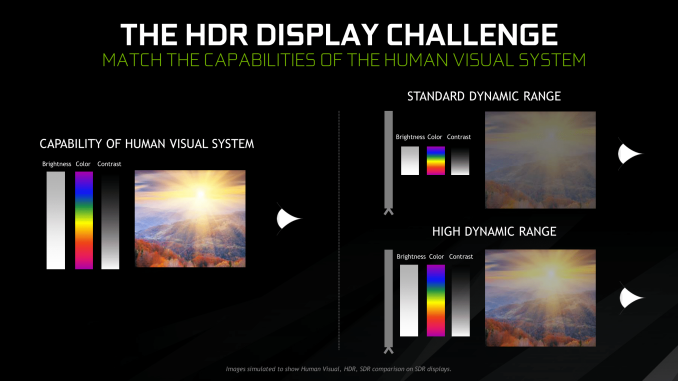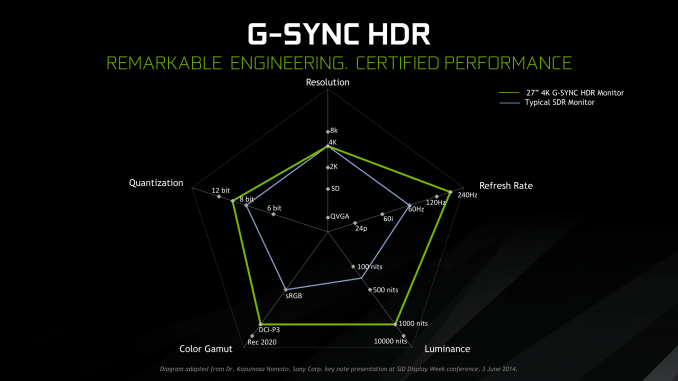The Asus ROG Swift PG27UQ G-SYNC HDR Monitor Review: Gaming With All The Bells and Whistles
by Nate Oh on October 2, 2018 10:00 AM EST- Posted in
- Monitors
- Displays
- Asus
- NVIDIA
- G-Sync
- PG27UQ
- ROG Swift PG27UQ
- G-Sync HDR
From G-Sync Variable Refresh To G-Sync HDR Gaming Experience
The original FreeSync and G-Sync were solutions to a specific and longstanding problem: fluctuating framerates would cause either screen tearing or, with V-Sync enabled, stutter/input lag. The result of VRR has been a considerably smoother experience in the 30 to 60 fps range. And an equally important benefit was compensating for dips and peaks over the wide ranges introduced with higher refresh rates like 144Hz. So they were very much tied to a single specification that directly described the experience, even if the numbers sometimes didn’t do the experience justice.
Meanwhile, HDR in terms of gaming is a whole suite of things that essentially allows for greater brightness, blacker darkness, and better/more colors. More importantly, this requires developer support for applications and production of HDR content. The end result is not nearly as static as VRR, as much depends on the game’s implementation – or in NVIDIA’s case, sometimes with Windows 10’s implementation. Done properly, even with simply better brightness, there can be perceived enhancements with colorfulness and spatial resolution, which are the Hunt effect and Stevens effect, respectively.
So we can see why both AMD and NVIDIA are pushing the idea of a ‘better gaming experience’, though NVIDIA is explicit about this with G-Sync HDR. The downside of this is that the required specifications for both FreeSync 2 and G-Sync HDR certifications are closed off and only discussed broadly, deferring to VESA’s DisplayHDR standards. Their situations, however, are very different. For AMD, their explanations are a little more open, and outside of HDR requirements, FreeSync 2 also has a lot to do with standardizing SDR VRR quality with mandated LFC, wider VRR range, and lower input lag. Otherwise, they’ve also stated that FreeSync 2’s color gamut, max brightness, and contrast ratio requirements are broadly comparable to those in DisplayHDR 600, though the HDR requirements do not overlap completely. And with FreeSync/FreeSync 2 support on Xbox One models and upcoming TVs, FreeSync 2 appears to be a more straightforward specification.
For NVIDIA, their push is much more general and holistic with respect to feature standards, and purely focused on the specific products. At the same time, they discussed the need for consumer education on the spectrum of HDR performance. While there are specific G-Sync HDR standards as part of their G-Sync certification process, those specifications are only known to NVIDIA and the manufacturers. Nor was much detail provided on minimum requirements outside of HDR10 support, peak 1000 nits brightness, and unspecified coverage of DCI-P3 for the 4K G-Sync HDR models, citing their certification process and deferring detailed capabilities to other certifications that G-Sync HDR monitors may have. In this case, UHD Alliance Premium and DisplayHDR 1000 certifications for the Asus PG27UQ. Which is to say that, at least for the moment, the only G-Sync HDR displays are those that adhere to some very stringent standards; there aren't any monitors under this moniker that offer limited color gamuts or subpar dynamic contrast ratios.
At least with UHD Premium, the certification is specific to 4K resolution, so while the announced 65” 4K 120Hz Big Format Gaming Displays almost surely will be, the 35” curved 3440 × 1440 200Hz models won’t. Practically-speaking, all the capabilities of these monitors are tied into the AU Optronics panels inside them, and we know that NVIDIA worked closely with AUO as well as the monitor manufacturers. As far as we know those AUO panels are only coupled with G-Sync HDR displays, and vice versa. No other standardized specification was disclosed, only referring back to their own certification process and the ‘ultimate gaming display’ ideal.
As much as NVIDIA mentioned consumer education on the HDR performance spectrum, the consumer is hardly any more educated on a monitor’s HDR capabilities with the G-Sync HDR branding. Detailed specifications are left to monitor certifications and manufacturers, which is the status quo. Without a specific G-Sync HDR page, NVIDIA lists G-Sync HDR features under the G-Sync page, and while those features are specified as G-Sync HDR, there is no explanation on the full differences between a G-Sync HDR monitor and a standard G-Sync monitor. The NVIDIA G-Sync HDR whitepaper is primarily background on HDR concepts and a handful of generalized G-Sync HDR details.
For all intents and purposes, G-Sync HDR is presented not as specification or technology but as branding for a premium product family, and right now for consumers it is more useful to think of it that way.














91 Comments
View All Comments
Ryan Smith - Wednesday, October 3, 2018 - link
Aye. The FALD array puts out plenty of heat, but it's distributed, so it can be dissipated over a large area. The FPGA for controlling G-Sync HDR is generates much less heat, but it's concentrated. So passive cooling would seem to be non-viable here.a5cent - Wednesday, October 3, 2018 - link
Yeah, nVidia's DP1.4 VRR solution is baffelingly poor/non-competitive, not just due to the requirement for active cooling.nVidia's DP1.4 g-sync module is speculated to contribute a lot to the monitor's price (FPGA alone is estimated to be ~ $500). If true, I just don't see how g-sync isn't on a path towards extinction. That simply isn't a price premium over FreeSync that the consumer market will accept.
If g-sync isn't at least somewhat widespread and (via customer lock in) helping nVidia sell more g-sync enabled GPUs, then g-sync also isn't serving any role for nVidia. They might as well drop it and go with VESA's VRR standard.
So, although I'm actually thinking of shelling out $2000 for a monitor, I don't want to invest in technology it seems has priced itself out of the market and is bound to become irrelevant.
Maybe you could shed some light on where nVidia is going with their latest g-sync solution? At least for now it doesn't seem viable.
Impulses - Wednesday, October 3, 2018 - link
How would anyone outside of NV know where they're going with this tho? I imagine it does help sell more hardware to one extent or another (be it GPUs, FPGAs to display makers, or a combination of profits thru the side deals) AND they'll stay the course as long as AMD isn't competitive at the high end...Just the sad reality. I just bought a G-Sync display but it wasn't one of these or even $1K, and it's still a nice display regardless of whether it has G-Sync or not. I don't intend to pay this kinda premium without a clear path forward either but I guess plenty of people are or both Acer and Asus wouldn't be selling this and plenty of other G-Sync displays with a premium over the Freesync ones.
a5cent - Wednesday, October 3, 2018 - link
"How would anyone outside of NV know where they're going with this tho?"Anandtech could talk with their contacts at nVidia, discuss the situation with monitor OEMs, or take any one of a dozen other approaches. Anandtech does a lot of good market research and analysis. There is no reason they can't do that here too. If Anandtech confronted nVidia with the concern of DP1.4 g-sync being priced into irrelevancy, they would surely get some response.
"I don't intend to pay this kinda premium without a clear path forward either but I guess plenty of people are or both Acer and Asus wouldn't be selling this and plenty of other G-Sync displays with a premium over the Freesync ones."
You're mistakenly assuming the DP1.2 g-sync is in any way comparable to DP1.4 g-sync. It's not.
First, nobody sells plenty of g-sync monitors. The $200 price premium over FreeSync has made g-sync monitors (comparatively) low volume niche products. For DP1.4 that premium goes up to over $500. There is no way that will fly in a market where the entire product typically sells for less than $500. This is made worse by the fact that ONLY DP1.4 supports HDR. That means even a measly DisplayHDR 400 monitor, which will soon retail for around $400, will cost at least $900 if you want it with g-sync.
Almost nobody, for whom price is even a little bit of an issue, will pay that.
While DP1.2 g-sync monitors were niche products, DP1.4 g-sync monitors will be irrelevant products (in terms of market penetration). Acer's and Asus' $2000 monitors aren't and will not sell in significant numbers. Nothing using nVidia's DP1.4 g-sync module will.
To be clear, this isn't a rant about price. It's a rant about strategy. The whole point of g-sync is customer lock-in. Nobody, not even nVidia, earns anything selling g-sync hardware. For nVidia, the potential of g-sync is only realized when a person with a g-sync monitor upgrades to a new nVidia card who would otherwise have bought an AMD card. If DP1.4 g-sync isn't adopted in at least somewhat meaningful numbers, g-sync loses its purpose. That is when I'd expect nVidia to either trash g-sync and start supporting FreeSync, OR build a better g-sync module without the insanely expensive FPGA.
Neither of those two scenarios motivates me to buy a $2000 g-sync monitor today. That's the problem.
a5cent - Wednesday, October 3, 2018 - link
To clarify the above...If I'm spending $2000 on a g-sync monitor today, I'd like some reassurance that g-sync will still be relevant and supported three years from now.
For the reasons mentioned, from where I stand, g-sync looks like "dead technology walking". With DP1.4 it's priced itself out of the market. I'm sure many would appreciate some background on where nVidia is going with this...
lilkwarrior - Monday, October 8, 2018 - link
Nvidia's solution is objectively better besides not being open. Similarly NVLINK is better than any other multi-GPU hardware wise.With HDMI 2.1, Nvidia will likely support it unless it's simply underwhelming.
Once standards catch up, Nvidia hasn't been afraid to deprecate their own previous effort somewhat besides continuing to support it for wide-spread support / loyalty or a balanced approach (i.e. NVLINK for Geforce cards but delegate memory pooling to DX12 & Vulkan)
Impulses - Tuesday, October 2, 2018 - link
If NVidia started supporting standard adaptive sync at the same time that would be great... Pipe dream I know. Things like G-Sync vs Freesync, fans inside displays, and dubious HDR support don't inspire much confidence in these new displays. I'd gladly drop the two grand if I *knew* this was the way forward and would easily last me 5+ years, but I dunno if that would really pan out.DanNeely - Tuesday, October 2, 2018 - link
Thank you for including the explanation on why DSC hasn't shown up in any products to date.Heavenly71 - Tuesday, October 2, 2018 - link
I'm pretty disappointed that a gaming monitor with this price still has only 8 bits of native color resolution (plus FRC, I know).Compare this to the ASUS PA32UC which – while not mainly targetted at gamers – has 10 bits, no fan noise, is 5 inches bigger (32" total) and many more inputs (including USB-C DP). For about the same price.
milkod2001 - Tuesday, October 2, 2018 - link
Wonder if they make native 10bit monitors. Would you be able to output 10bit colours from gaming GPU or only professional GPU?